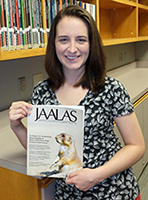May 17, 2017
Cover of academic journal highlights research by new K-State veterinary graduate

Getting an article published in an academic journal can be quite an accomplishment — even for a seasoned researcher. To have that work featured on the cover of a journal is rarer yet. Valerie Head, Salt Lake City, Utah, can now add that accomplishment on top of earning her Doctor of Veterinary Medicine degree in May.
The Journal of the American Association for Laboratory Animal Science, also known as JAALAS, selected "Techniques for Nonterminal Blood Sampling in Black-Tailed Prairie Dogs (Cynomys ludovicianus)" as the lead cover article in its March 2017 issue. Head wrote the article as a student under the guidance of David Eshar, assistant professor of companion exotic pets, wildlife and zoo animal medicine in the College of Veterinary Medicine, and with help from Melissa Nau, a former intern in the Veterinary Health Center at Kansas State University.
"This is a nice gesture and an honor for anyone, let alone a student," Eshar said. "JAALAS is the most respected journal in its field, and we have received numerous responses from people who saw the article. This is important work. Black-tailed prairie dogs are used as an animal model for research on gallbladder stones and several infectious diseases, kept in zoological collections and also as privately owned pets, so having proper techniques for obtaining blood samples would be very valuable for that purpose."
"I had been unable to find where a comprehensive, instructive resource on the appropriate techniques for venipuncture and the collection of nonterminal blood samples had ever been published in regard to this species," Head said. "The detailed and illustrated information we presented in the article can aid clinicians and researchers in handling these animals and in performing venipuncture and anesthesia. Having this work put on the cover of the journal is very exciting."
Head will work in a small animal and exotic medicine practice in Texas, where she will treat similar animals in a clinical setting, and continue contributing to veterinary medical literature.
